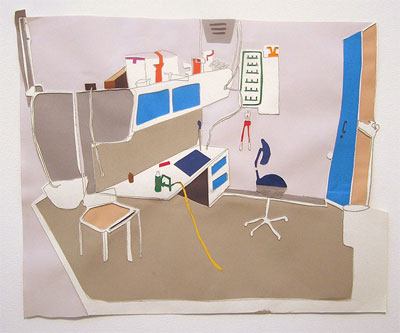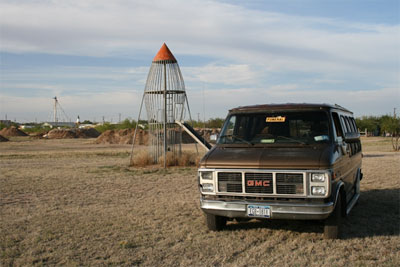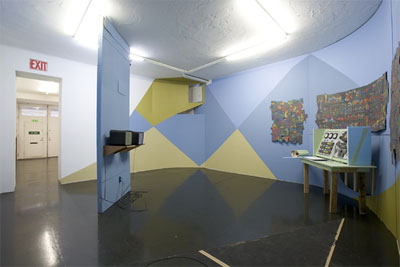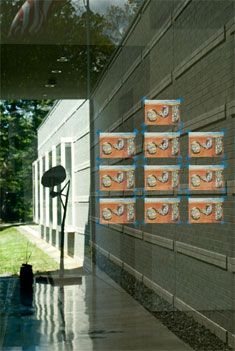
Now that progress is as predictable as an automatic software update or higher resolution in a camera phone, the idea that technological advancement holds the key to a better future -- and the fear that it could be abused as a tool of world domination -- seem like quaint relics of the 1950s and '60s. Lisi Raskin's exaggeratedly ragged, hand-crafted reconstructions of military command centers evoke the thrall such spaces held over the public imagination during the Cold War even as they reinforce the contemporary viewer's distance from that feeling of awe. Over the past year, Raskin's installations on this topic have surfaced in several locations as stages of an ongoing project titled Mobile Observation. This year's incarnations began with Command and Control, an installation at the Park Avenue Armory in February, and continued with Mobile Observation (Transmitting and Receiving) Station at Bard College's Hessel Museum of Art, for which she embarked on a road trip to military sites across the United States and sent back materials to be exhibited. Mobile Observation will peak this Friday with Tipping Point, a performance at the opening of "Soft Manipulation" at Casino Luxembourg, where the resulting debris will remain on view through the exhibition's run. Here Raskin, who works at studios in Brooklyn and Oakland, California, discusses her newest work and how it represents a change in her perception of Cold War mythology. - Brian Droitcour
Could you describe Tipping Point and how it continues Mobile Observation?
The event relies heavily on the contributions of Nina Hoffmann and Jens Lind. Jens will play a security guard or border patrolman before the speech begins. His presence at Casino's entrance is meant to present an immediate psychic obstacle to those entering the space. Once Nina begins her lecture, Jens will assume the position of her bodyguard, acting like a secret service agent while a government VIP is on stage. Nina's character started her career as someone who was just doing what she was told, but soon became entranced and seduced by the ideas and the power she could access. Her text started out as a straightforward lecture that I compiled from various internet sources and has evolved into a long poem about game theory, which explains in wiki-depth some of the theoretical aspects of nuclear strategy like Mutual Assured Destruction. In the performance, Nina will use tropes like former Defense Secretary Donald Rumsfeld's hand gestures to evoke his essence during her reading, the way one might evoke a spirit during a séance. I imagine the extreme range of Nina's character to span a fervent enthusiasm for American military might, sexual fetish of some of the more phallic components of the arsenal, like missiles and submarines, and then this quasi-mystical and trance-like relationship with the Cold War application of game theory. I will also perform as a member of the fringe element -- a character who may cause a disruption or erupt into cheers of reverence in response to the more intense moments of Nina's reading. My character may even get on stage at some point.
I don't feel that a description of the performance would be complete without a description of the surrounding architecture, drawings and sculptures as these elements play an important part in the overall ethos of the work. Imagine the structure as a barbed-wire and chain-link fence about 15 feet tall, the likes of which one might find at a maximum security penitentiary, a structure suggesting something wrong is bound to happen or anticipating a disruption or imminent violence. But my structure will be made from found and collaged wood, which refers to the way I have used that material throughout Mobile Observation. I will hang two large, handmade American-flag collages stretching about 15 feet across the structure, as a symbol capable of summoning the power of the state. In an effort to provide some sort of weapon for the viewer, I will scatter papier-mâché sticks about the space. While these sculptures take the form of sticks, they function like inverted piñatas; if one were to actually use them to strike another, denser object, they would rupture. I will also install a speakeasy at the back of the structure, where we will wantonly provide social lubrication. So these are the variables of the experiment. I am looking forward to seeing how they will function in real time.

When Mobile Observation (Transmitting and Receiving) Station was shown at CCS Bard earlier this year, the work was produced remotely and transmitted to the exhibition site. Now the action all happens in one place, in an installation designed to accommodate both a performance and its audience. What informed your reconceptualization of space?
I think that the most startling difference in the way that I am conceptualizing the space of this artwork has to do with both the nature of the narrative and the fact it is going to be enacted in front of a live audience. See, during my research trip to the Titan Missile Museum in Tucson I interviewed three missileers about their experiences on crew duty in the silo, and their responses to my questions pretty much blew my mind. In the earlier work, I had been absorbed in the process of creating and projecting a fairly romantic narrative onto the works. The same was true for how I constructed Command and Control, the installation at the Park Avenue Armory that preceded the road trip component of Mobile Observation. This installation relied heavily on the romance of the secret chamber and how it functioned specifically during the Cold War. But my actual visit to the Titan silo revealed several things that I hadn't previously considered. For example, there were women working in the silo as commanders of the alert crews. And as the interviews wore on, I began to realize that what was actually going on in the missile silo and command center had more to do with bureaucracy than romance. The crew on alert was inundated with tasks and checklists; they were under pressure to perform their duties to the fullest, or else they risked being severely reprimanded or relieved of duty. What I hadn't understood prior to my trip was that the local pressure that Strategic Air Command was putting on each individual actually loomed larger than the overall pressure of the Cold War and nuclear annihilation.
As I moved forward in my thoughts about bureaucratic time, I began to really think about how this power relationship might have functioned and how the architecture I make could be informed by this discovery even further. For the last several months I have been playing these discoveries over and over in my mind, and the other day I had one of those strange and infrequent moments when everything comes together in the studio. Earlier in the day, I had a conversation with my partner, Allison Smith, and she asked me why I was doing this particular performance at this particular historical moment. I didn't have a very good answer for her. So I thought, Who can I ask about this? Immediately I thought, I need Foucault, but quickly realized that I had sent my Foucault to California. Then I thought, OK, how about Bataille? But then realized that the Bataille book was on its way to California as well. In a frustrated moment I began to scan the theory section of my bookshelves and found myself staring directly at Michael Taussig's book, The Magic of the State. I opened the book to a chapter called "Art Adrift in the Crowd" and found a quote about defacement of monuments and the quasi-religious power of the state, how these ideas get exorcised. I thought, Holy shit, that's it! There was even a small black-and-white rendering of a town square with a military memorial in it, which was just another way of conceiving of the space that I had been drawing for weeks. So thanks Allison and Michael, I owe you both one...

Why do you think the mythology of the Cold War remains so potent today?
We are living the sordid legacy of the Atomic Age. We have no idea who our enemies are or how they might strike, and, unfortunately, we also have loose nukes -- unsecure elements of the former Soviet nuclear arsenal. Elder statesmen like Henry Kissinger and Sam Nunn are calling for nuclear disarmament. And you know that the global security situation has gone from bad to worse when the hawks are scared. It is frightening to hear those who know the intimate details of the state of global security confess that they long for the Cold War, but I have heard the confessions, the longing for a simpler time. They long for the days of the one-front wars, the polemic of them against us, of good and evil.
I think that today it is no longer possible to make these kinds of distinctions because, just as the nature of the conflict has changed, so has the theoretical framework we use to analyze the conflict. By this I mean that maybe now the political elite can interpret how the Cold War has influenced the growth of radical fundamentalism both inside and outside of the United States. I think this type of self-awareness and the possibility that it might influence policy is really a recent development, which of course only complicates things further.
On another level, it is important to understand that the Cold War was a global condition for over 60 years. With respect to the individuals who experienced the Cold War firsthand, I could hardly reduce the residual potency of the Cold War solely to its mythology. Collectively, we have internalized the Cold War. It lives within us, and it has shaped the thinking of many adults on the planet. I do think that there are behavioral cycles and governmental tactics that started during the Cold War and still resonate today. For example, one can draw a fairly apt analogy between the McCarthy era's witch hunts for communists and the Bush administration's witch hunt for terrorists here in the United States. Would this type of manipulation be so successful if we had not internalized McCarthyism?
Also, it is no coincidence that the Department of Defense and various other governmental agencies are still lying to the general public about the health risks associated with radioactivity. It is also true that the military-industrial complex has been running the show ever since Ronald Reagan’s tenure in office, and most importantly, there are more than 60,000 nuclear weapons in the world of various yields and in various forms, still ready to be used at a moments notice. Regarding the nuclear arms security situation, whatever stasis existed during the Cold War has swung off the (real or perceived) binary into an untenable situation. Russia and NATO have both explicitly stated that they would use nuclear weapons preemptively. If the Cold War was good for anything, it was the promise and struggle for no first use of atomic weapons.

How did you arrive at your decision to recreate high-tech equipment in a do-it-yourself, handcrafted aesthetic?
Well, my aesthetic explorations over the last 10 years have evolved mostly through a process of trial and error, punctuated by two prominent incidents that I have understood as definite readings of my objects in the "real world," as opposed to an "art world" context. One of these events happened while I was a grad student at Columbia. I was part of a group show with a provocative title, something like "Power and Violence," and I had lent an assemblage called Bomb. Its components consisted of a safety can for oily rags (as is customarily used in painting class) and some soda bottles with blue colored water in them. I had glued these soda bottles to the can and run a set of wires through some crayons, also glued to the soda bottles. The wires were ultimately attached to some modeling clay on the top of the can. This modeling clay was meant to resemble a C-4 explosive. At the time, I was exploring the connection between the aesthetics of bricolage and the aesthetics of terrorism, and I found that certain kinds of art objects and certain improvised explosive devices had a lot in common once both objects were removed from their intended contexts. I lent the object to the show with this in mind. However, when the university's weekend security guard came by on his usual rounds and saw the sculpture through the gallery window, when he was alone with it in the dark, it scared him so badly that he called the NYPD bomb squad.
I found out about the incident because a classmate of mine was attending a makeup printmaking workshop when the entire building had to be evacuated because of the bomb scare. Keep in mind that this was the fall of 2002, so everyone was still a bit on edge. It was also after normal business hours so none of the usual individuals who work at the university were present. There were no administrative assistants to reassure this fellow.
As students of art and art theory, we are taught that if something like the aforementioned scenario transpires and art "shocks" the viewer, the piece in question is successfully "avant-garde." But for me there were some serious questions that came up after the incident. For example, did the weekend security guard actually fall into the category of the viewer? This question spiraled into larger questions about the way that the aesthetics of simulation actually function during a moment when an object passes for its "real-world" counterpart. In the mind of the security guard, my sculpture caused a response that could be attributed to a much larger and more ubiquitous fear campaign being waged on the American people by the Bush administration. The weekend security guard was not on a leisurely stroll around town deciding that he might look at some art. He was not having a flaneur moment. He had not entered a consensual situation where he was suspending his disbelief upon entering an art installation. In fact, he had confused my sculpture for the real thing. I could empathize with the mechanics of his experience and response because I often mistake someone's momentarily abandoned shopping bags on the subway platform for some packages that could contain explosives. So why did this happen? What had I taken for granted? Had my gesture been reckless?
Probably the most important guide for me through this dilemma was my best friend, the painter Marc Handelman. We would have these great conversations about fiction in sculpture and the difficulties implicit in engaging the space that the real world also inhabits, which is the predicament of sculpture. How could I make objects that would lure you in because you think they are fakes? Was this also a way to intelligently contribute to the existing discourse of critique that had employed simulation as an aesthetic device? Could this new strategy work? Marc kept saying that drawing and painting always signal a more fictive space to the viewer, and a representation of Bomb would not have incited the same questions of fear, violence, and terrorism. The problem for me became how to collapse the space of sculpture into a space that would immediately signal fiction to the viewer, and maybe even bring the initial level of anxiety down a notch so that a more prolonged relationship with the object could be possible.

